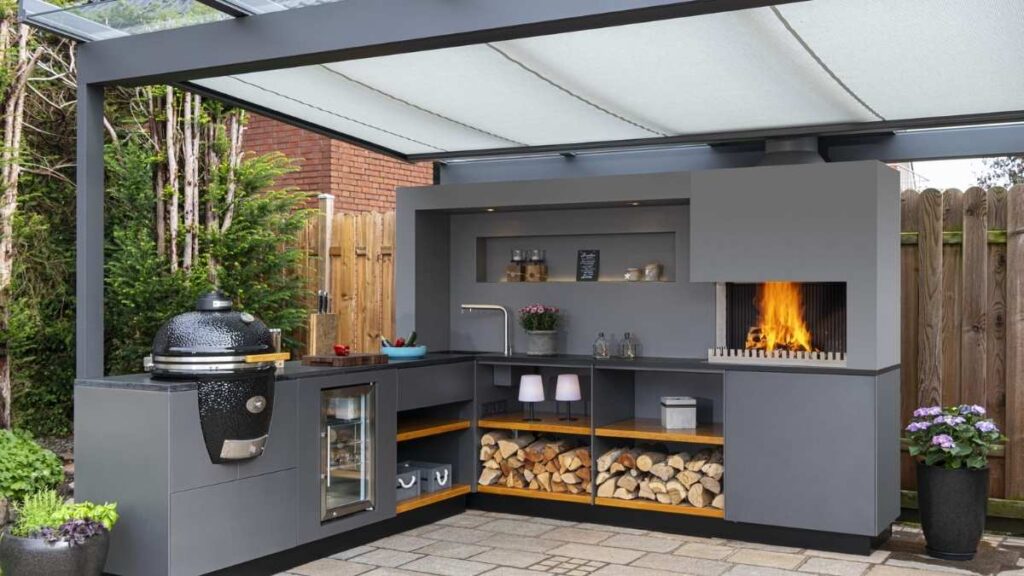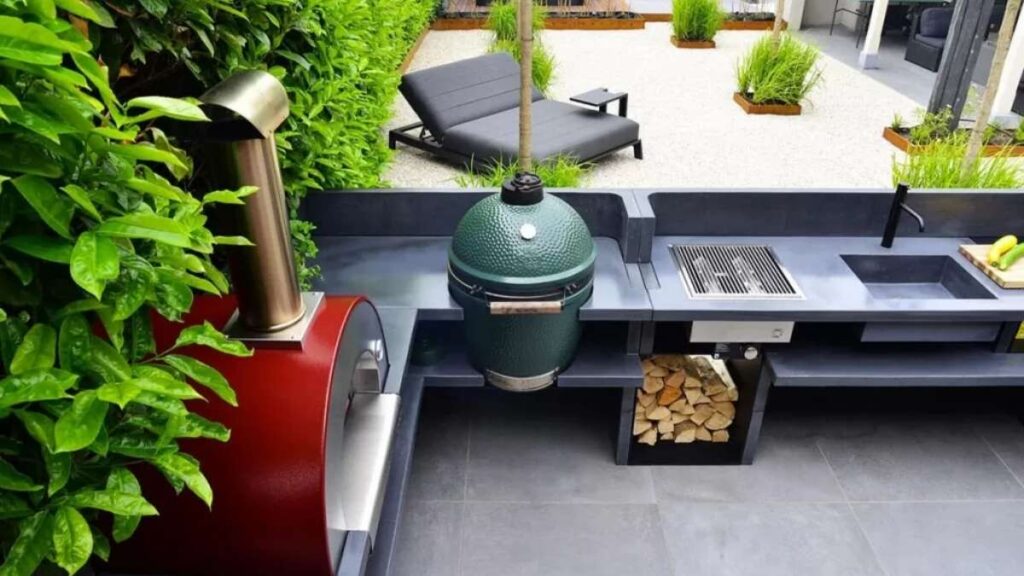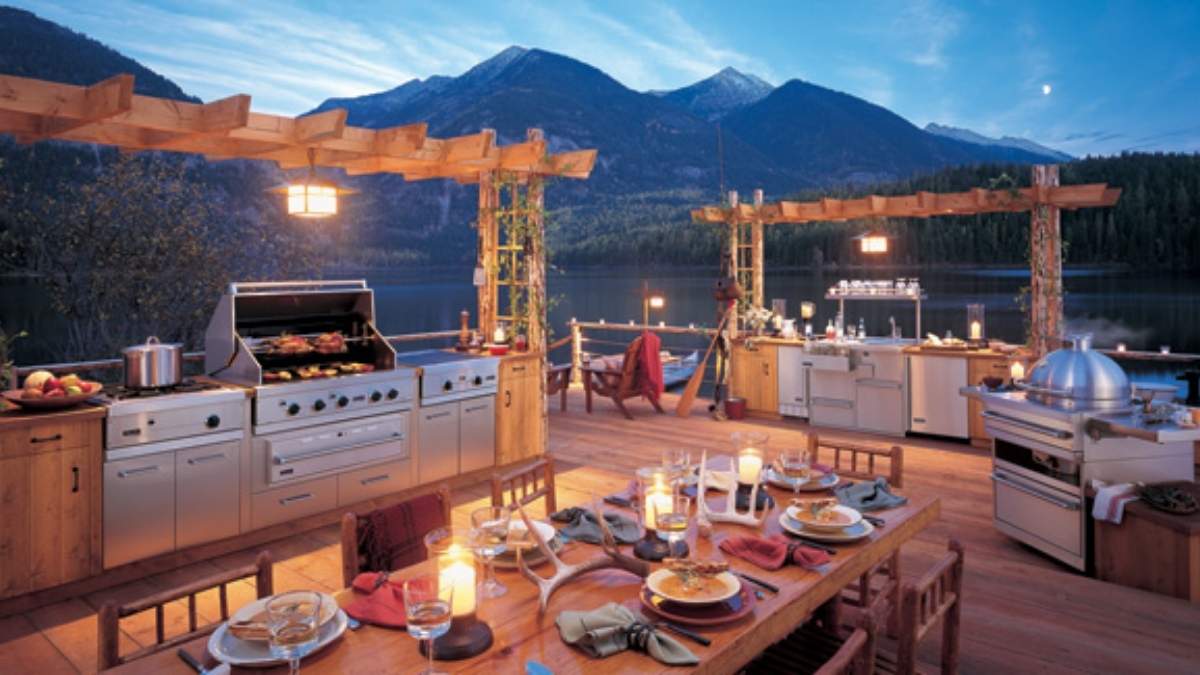An outdoor kitchen roof ideas transforms a basic cooking space into an all-weather entertainment zone, protecting both equipment and people from rain, snow, and harsh sunlight. Regardless of the season, a well-designed covering extends the grilling season and shields valuable cooking equipment from rust and corrosion.
Furthermore, these protective structures do more than just shelter from the elements. A properly planned outdoor kitchen roof can significantly boost home value while making the space more functional. From retractable awnings that adjust to changing weather conditions to sturdy pergolas offering consistent shade, homeowners have multiple options to enhance their outdoor cooking areas. Essentially, the right roof solution ensures the space remains usable and equipment stays protected throughout the year.
Let’s discover practical designs, weather-resistant options, and maintenance tips to create a durable, all-season cooking space.
Understanding Outdoor Kitchen Roof Basics
Selecting the right outdoor kitchen roof ideas begins with understanding fundamental aspects that influence both functionality and longevity. A properly designed roof structure serves as the first line of defense against various environmental elements, making it a crucial component of any outdoor cooking space.
Key benefits of covered outdoor kitchens
A well-planned roof covered outdoor kitchen offers multiple advantages that enhance the overall outdoor living experience. According to industry data, 75% of outdoor kitchens without covers require more frequent maintenance and repairs. Here are the primary benefits:
- Protection for appliances and materials from direct exposure to elements
- Extended lifespan of kitchen components and equipment
- Increased comfort for cooking and entertaining
- Enhanced property value through additional usable space
- Year-round accessibility regardless of weather conditions
Moreover, a covered kitchen eliminates the constant need for removing and replacing individual appliance covers. Additionally, the structure helps maintain cleaner cooking surfaces and protects outdoor furniture from sun damage.
Common weather challenges to address
When planning outdoor kitchen ideas with roof structures, several weather-related challenges require careful consideration. Specifically, high humidity and frequent rainfall demand moisture-resistant materials like stainless steel, concrete, or treated wood.
The roof design must account for proper ventilation, particularly in enclosed spaces where smoke can accumulate. Consequently, many homeowners opt for automated ventilation systems or strategic roof placement to ensure smoke dispersal.
In regions with extreme temperatures, the roof backyard covered outdoor kitchen ideas should incorporate features for both summer and winter protection. During summer months, the structure provides essential shade from intense sun exposure, making cooking more comfortable. Throughout winter, proper coverage prevents snow accumulation and protects against freezing temperatures that could damage water lines or crack countertops.
Structural integrity remains paramount when addressing these weather challenges. The roofing materials must withstand various conditions while complementing the home’s architectural style. Professional designers recommend selecting materials based on local climate patterns and specific weather concerns.

Popular Outdoor Kitchen Roof Designs
Modern outdoor kitchen roof ideas encompass a range of innovative designs that blend functionality with esthetic appeal. From traditional structures to automated solutions, each design offers unique advantages for outdoor cooking spaces.
Pergola-style roofs
Pergolas remain a timeless choice for outdoor kitchen ideas with roof structures, offering both charm and practicality. These structures consist of vertical pillars supporting an open lattice of beams, creating a distinct outdoor room feel. The design allows filtered sunlight while providing partial shade protection.
Modern pergola roof designs offer customization options including:
- Outdoor ceiling fans for improved airflow
- Integrated LED lighting systems
- Water misting systems for temperature control
- Sound system integration capabilities
Solid roof structures
Solid roof structures provide the most comprehensive protection for roof covered outdoor kitchen ideas. These permanent installations effectively shield cooking equipment and seating areas from various weather conditions. Primarily constructed using materials like powder-coated aluminum or traditional asphalt shingles, these structures seamlessly extend the home’s existing roofline.
Gable and hip roof designs subsequently enhance visual appeal while ensuring proper water runoff. Indeed, proper ventilation becomes crucial in these structures – incorporating ridge vents or power ventilation systems helps manage cooking smoke effectively.
Retractable covers
Alternatively, retractable roof backyard covered outdoor kitchen ideas offer unmatched versatility. This design style is also seen in modern patio roofs. These systems combine the best aspects of open-air cooking with reliable weather protection. Premium models notably include rain sensors that automatically close at the first sign of precipitation.
The motorized louvered roof systems can be adjusted precisely, allowing homeowners to control sunlight exposure and ventilation. These smart covers primarily operate with simple button controls, enabling quick adjustments based on weather conditions or personal preference.
For enhanced functionality, many retractable systems include integrated LED lighting, extending outdoor cooking hours well into the evening. The flexibility of these covers makes them particularly suitable for varying weather conditions, though the initial investment typically exceeds that of traditional fixed structures.
Smart Features for All-Weather Protection
Smart technology has redefined how outdoor kitchen roof ideas protect cooking spaces from weather challenges. Advanced features now offer unprecedented control over the outdoor environment, making these spaces functional throughout the year.
Automated ventilation systems
Sophisticated ventilation technology complete with smoke vents ensures optimal air quality beneath outdoor kitchen roof ideas. These systems employ smart sensors that detect various environmental factors, automatically adjusting ventilation levels as needed. Pre-engineered rooftop ventilators deliver fresh outside air while removing smoke, excess humidity, and harmful gasses.
The latest ventilation solutions include:
- Variable speed components that match heating and cooling capacity to required loads
- User-friendly interfaces for easy programming
- Integration with building management systems
- Automatic pollutant detection and removal capabilities
Integrated lighting solutions
For roof covered outdoor kitchen ideas, LED lighting stands out as the premier choice, offering both practicality and ambiance. These fixtures combine energy efficiency with exceptional durability, making them ideal for outdoor applications. The lighting systems primarily focus on three crucial areas: task lighting for cooking surfaces, ambient lighting for dining spaces, and accent lighting for esthetic appeal.
LED systems offer remarkable versatility through adjustable color temperatures and beam angles, ensuring proper illumination for every activity. Initially designed for durability, these fixtures withstand various weather conditions while maintaining consistent performance.
Climate control options
Climate management represents a significant advancement in roof backyard covered outdoor kitchen ideas. Mini-split systems have emerged as an efficient solution, offering both heating and cooling capabilities. These units deliver precise temperature control without requiring extensive ductwork, making them perfectly suited for outdoor kitchen spaces.
The systems boast several advantages, including energy-efficient operation and customizable comfort settings. Alternatively, automated temperature control systems work in conjunction with weather-resistant materials to maintain optimal conditions. These smart features ultimately create a comfortable cooking environment, regardless of external weather conditions.
The integration of these smart features beneath outdoor kitchen ideas with roof structures has transformed seasonal spaces into year-round entertainment zones. Through careful consideration of ventilation, lighting, and climate control, these technological additions ensure maximum functionality and comfort in any weather scenario.

Weather-Resistant Materials and Construction
The selection of materials and structural elements for outdoor kitchen roof ideas demands careful consideration of local weather patterns and environmental factors. A thoughtful combination of durable materials and proper construction techniques ensures long-term functionality and protection.
Top roofing materials for durability
The choice of roofing materials for roof covered outdoor kitchen ideas primarily depends on regional climate conditions and esthetic preferences. Stainless steel emerges as a premier choice, offering exceptional heat and weather resistance. Nevertheless, in coastal areas, marine-grade stainless steel (316 grade) proves superior due to its enhanced corrosion resistance.
For outdoor kitchen ideas with roof structures, several materials stand out:
- Aluminum: Lightweight yet durable, ideal for larger structures
- Steel: Superior strength, fire-resistant properties
- Synthetic thatch: 20-year warranty, flame-resistant qualities
- Polycarbonate panels: UV protection while allowing natural light
Alternatively, high-density polyethylene (HDPE) demonstrates remarkable durability against UV exposure, albeit requiring proper ventilation. This material also common for porch roofs maintains its integrity without fading, therefore making it suitable for long-term outdoor applications.
Structural requirements for different climates
The structural integrity of roof backyard covered outdoor kitchen ideas varies significantly based on geographical location. In Southern California and Arizona, lighter structures focusing on shade suffice, whereas regions with frequent rainfall require waterproof, solid roof constructions.
Proper drainage systems become essential for directing water away from the kitchen area. Furthermore, the installation of footings beneath support columns ensures structural stability. The roof load capacity requires careful calculation – typically 4.21 kN/m2 (90 psf) for standard installations.
For areas experiencing extreme weather conditions:
- Snow-prone regions demand stronger support structures
- Storm-prone areas require wind-resistant designs rated for minimum 60 mph winds
- Coastal locations need additional anchoring and reinforcement
In freeze-prone areas, water systems require special consideration. Stop and waste valves installed in conditioned spaces allow for seasonal drainage. The size of rafters and beams must align with local building codes, considering factors such as span distance and pitch requirements.
The structural design should also account for proper ventilation, allowing grill smoke to escape while preventing overheating. For year-round functionality, the integration of seasonal maintenance features becomes paramount, such as accessible drainage points and removable components for winter storage.
Maintenance Tips for Outdoor Kitchen Roofs
First and foremost, regular maintenance ensures outdoor kitchen roof ideas remain functional and esthetically pleasing throughout changing seasons. A well-maintained roof structure not only protects valuable outdoor kitchen components but similarly extends their lifespan significantly.
Seasonal maintenance checklist
Monthly maintenance forms the foundation of proper outdoor kitchen roof care. A thorough cleaning routine includes deep cleaning all countertops and surfaces with appropriate cleaners for specific materials. In addition, inspecting grills, burners, and cooking appliances for debris accumulation proves crucial for optimal performance.
Quarterly tasks demand more comprehensive attention:
- Reseal countertops and stone surfaces to prevent water damage
- Check plumbing systems and repair any leaks promptly
- Apply water-resistant sealant to wooden components
- Inspect structural integrity and address minor issues
Biannual preparations primarily focus on winterization and summer readiness. Before winter sets in, thoroughly clean and dry all components, remove residual water from pipes, and protect plumbing with proper insulation. For summer preparation, inspect all components for winter damage and address any issues immediately.
Weather damage prevention
Protecting outdoor kitchen roof ideas from weather-related damage requires strategic planning and preventive measures. For roof covered outdoor kitchen ideas, galvanized steel structures demonstrate exceptional durability, withstanding winds up to 100 mph when properly anchored. Alternatively, roof backyard covered outdoor kitchen ideas benefit from PRO-TECT™ tested materials that can support up to 50 pounds of snow per square foot.
For enhanced protection, consider installing automated ventilation systems that regulate temperature and moisture levels. Regular inspections after severe weather events help identify potential damage early. Proper drainage systems and strategic placement of vents prevent water accumulation and ensure proper airflow.
Winter protection deserves special attention for outdoor kitchen ideas with roof structures. Drain all water lines and shut off water valves to prevent freezing. Cover fixed elements with weather-resistant materials, and where possible, store removable components indoors during harsh winter months.
The implementation of proper ventilation proves essential for preventing moisture-related issues. Avoid completely waterproof covers as they can trap moisture, potentially leading to mold growth and surface discoloration. Instead, opt for breathable materials that provide protection while allowing adequate airflow.
Annual maintenance should include a comprehensive inspection of the entire structure, focusing on:
- Checking for cracks in stone or concrete
- Treating metal structures with rust-proofing solutions
- Verifying the integrity of electrical wiring
- Ensuring proper function of fire safety equipment
Outdoor Kitchen Roof Ideas Frequently Asked Questions
Is a roof necessary for an outdoor kitchen?
While not mandatory, a roof is highly recommended for outdoor kitchens. It protects your investment from weather damage, extends the lifespan of appliances and materials, and allows for year-round use of the space regardless of weather conditions.
What are the best materials for an outdoor kitchen roof?
The best materials depend on your climate, but popular choices include stainless steel, aluminum, and synthetic thatch. For coastal areas, marine-grade stainless steel is ideal due to its enhanced corrosion resistance. Polycarbonate panels are also a good option as they provide UV protection while allowing natural light.
How can I protect my outdoor kitchen from extreme weather?
To protect your outdoor kitchen from extreme weather, consider installing a solid roof structure, implementing proper drainage systems, and using weather-resistant materials. For areas prone to storms, choose wind-resistant designs rated for at least 60 mph winds. In snow-prone regions, ensure stronger support structures capable of handling snow loads.
What smart features can I add to my outdoor kitchen for all-weather use?
Smart features for all-weather use include automated ventilation systems, integrated LED lighting solutions, and climate control options like mini-split systems. These features help maintain optimal air quality, provide proper illumination, and ensure comfortable temperatures regardless of external weather conditions.
How often should I maintain my outdoor kitchen roof?
Regular maintenance is crucial for outdoor kitchen roofs. Perform monthly cleaning of all surfaces and appliances. Conduct quarterly inspections of plumbing systems, sealants, and structural integrity. Biannual preparations should focus on winterization before cold weather sets in and summer readiness as warmer months approach. After severe weather events, always inspect for potential damage.
